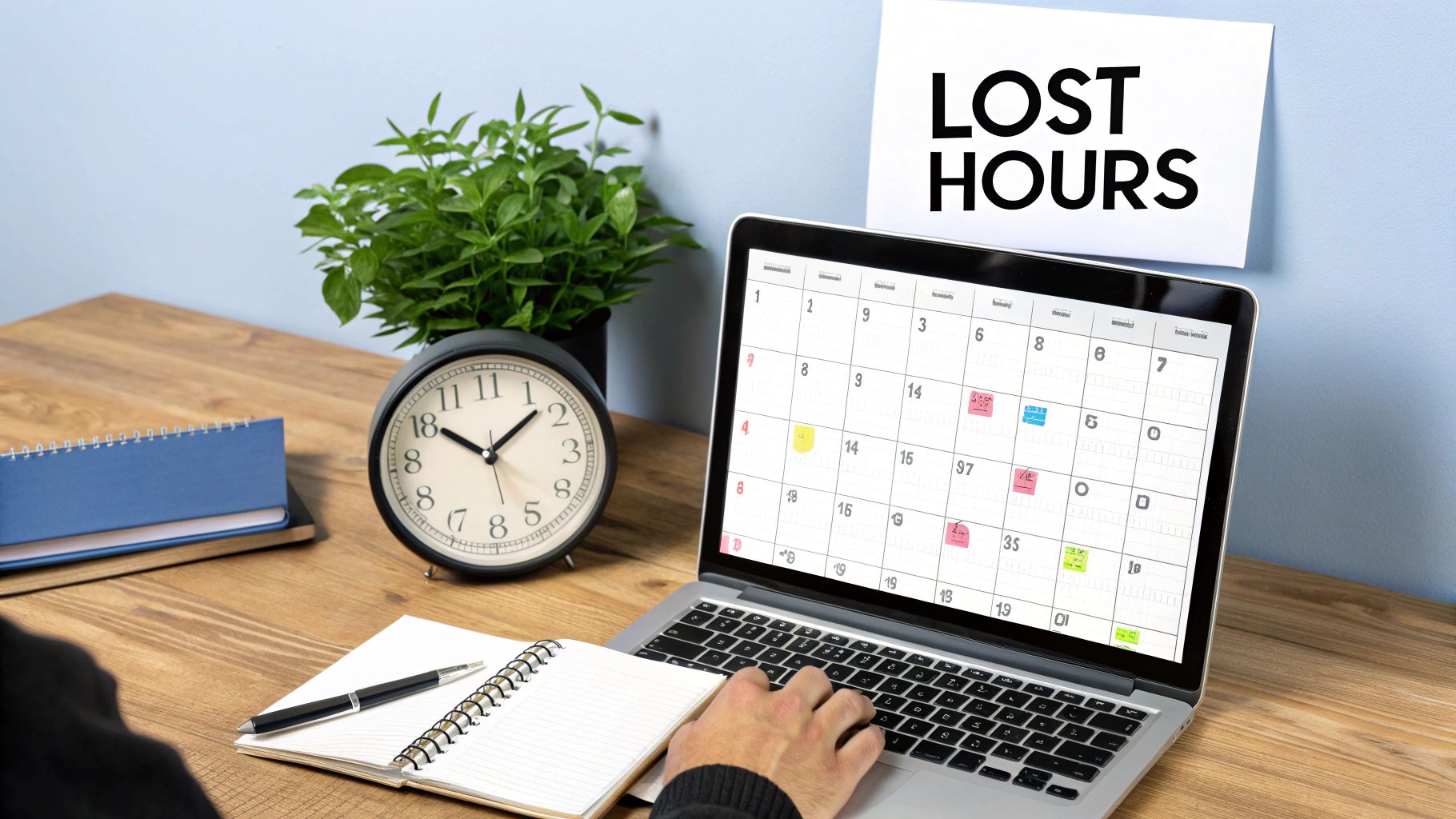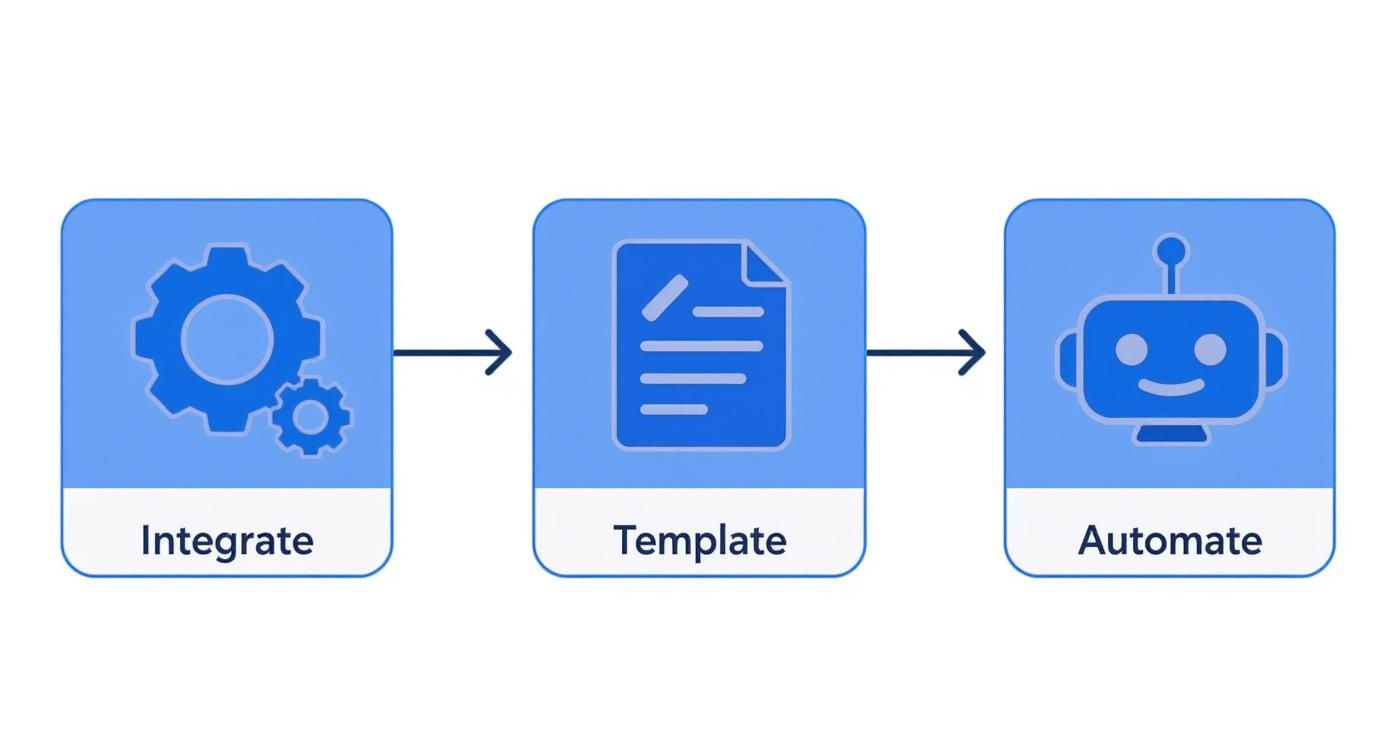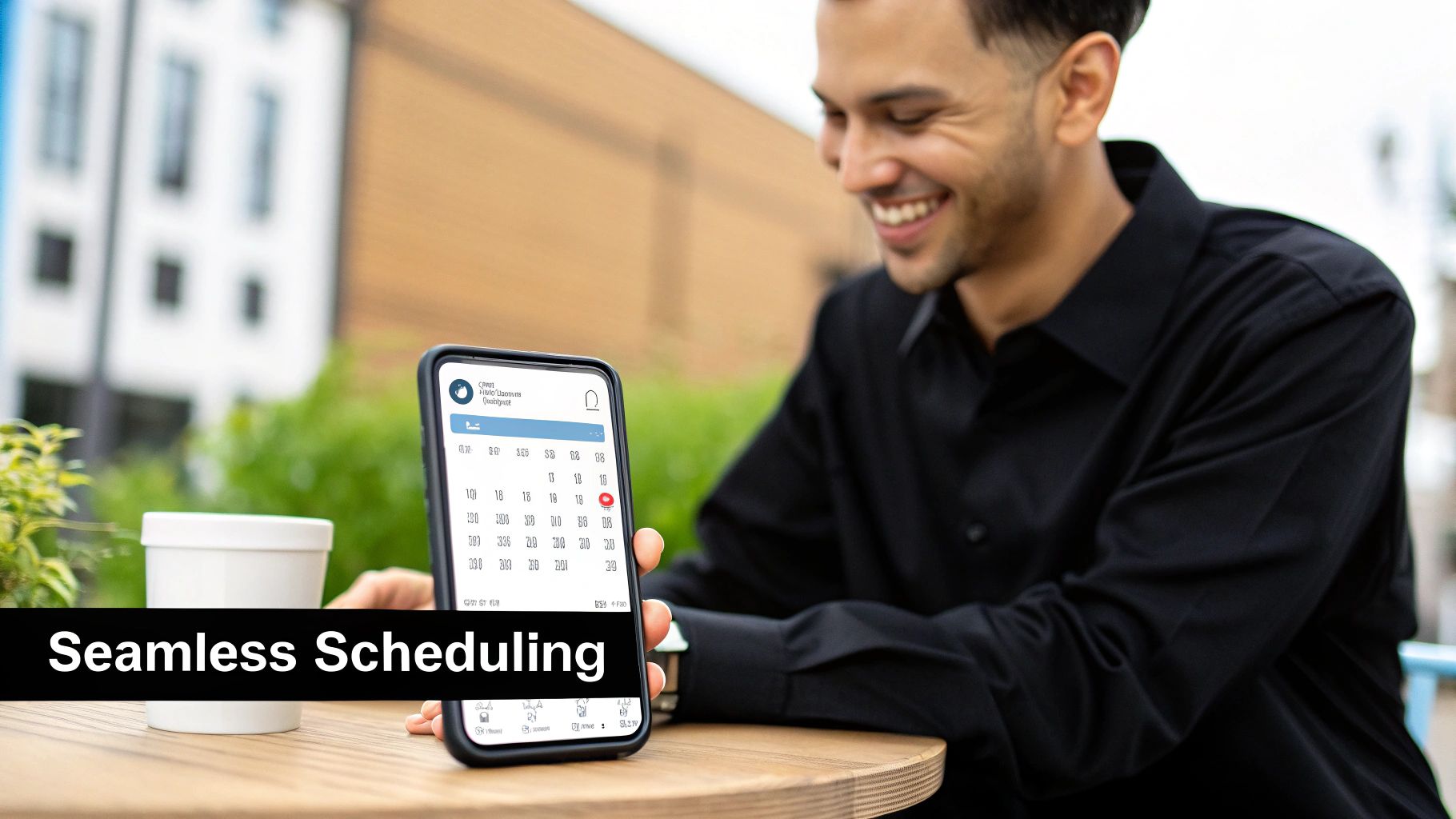Automate Interview Scheduling and Reclaim Your Time
- Janis Kolomenskis
- 7 days ago
- 12 min read
We've all been there. That sinking feeling as you stare at your inbox, bracing yourself for another round of "calendar Tetris." You've found an amazing candidate, the hiring manager is pumped, and then... the dreaded scheduling dance begins. It's more than just a little annoying; it's a full-blown productivity killer that grinds your entire hiring process to a halt.
The True Cost of Manual Interview Scheduling

Let's be real: trying to align schedules across different time zones and jam-packed calendars is one of the biggest hidden bottlenecks in talent acquisition. The momentum you worked so hard to build with a great candidate can vanish in an instant, all thanks to a simple scheduling conflict.
The sheer amount of time wasted is mind-boggling. Research consistently shows that recruiters can spend up to 35% of their time just wrestling with interview logistics. Think about that—that's hours every single day that could be spent sourcing incredible talent, building relationships, or actually talking to candidates.
By automating this mess, teams are reclaiming anywhere from 3 to 5 of those precious hours daily. In fact, you can read the full research on recruitment automation findings to see how some companies have slashed their hiring cycle times by an incredible 60%.
It's About More Than Just Wasted Hours
But the damage goes way beyond lost time. Every single delay, every "let me check and get back to you," is another chance for your best candidates to lose steam or, even worse, accept a competing offer.
A slow, clunky scheduling process screams, "we're disorganized" or "we don't value your time." This directly torpedoes your employer brand and is a huge reason for high candidate drop-off rates.
Think about the domino effect of this one bottleneck:
A Terrible First Impression: Scheduling is often a candidate's first real taste of your company's internal operations. A smooth, modern process sends a powerful message. A messy one sends an even louder one.
Frustrated Hiring Managers: If scheduling is a pain, hiring managers check out. This creates internal friction and slows everything down even more.
Losing the Race for Talent: In a hot market, speed is everything. The company that gets a candidate from application to offer the fastest usually wins. Period.
The real damage of manual scheduling isn't just the hours your team loses; it's the top-tier candidates you lose while you're busy coordinating calendars.
At the end of the day, sticking with manual scheduling is like insisting on walking everywhere when you have a perfectly good car waiting. Sure, you might get there eventually, but you’ll be exhausted, late, and you’ll have missed a ton of great opportunities along the way.
Designing Your Automated Scheduling Workflow
Alright, let's get our hands dirty and build the blueprint for an interview scheduling system that actually works for you. This is the fun part—where we move from theory to practice. A truly great workflow isn't about just switching on a tool; it's about thoughtfully designing a process that respects the time of your team, your hiring managers, and, most importantly, your candidates.
The bedrock of any automated scheduling setup is how it talks to your other systems. Your Applicant Tracking System (ATS) is your single source of truth for everything candidate-related, so a seamless, two-way integration is an absolute must-have. When a candidate books an interview, their status should instantly update in the ATS. No more manual data entry, no more human error.
The same goes for your calendars. Deep integration with Google Calendar or Outlook is non-negotiable. Your scheduling tool needs real-time access to everyone's availability to stop double-bookings in their tracks and find the perfect slot without a single "when are you free?" email.
Building Smart Workflow Templates
Let's be real: a one-size-fits-all scheduling link is a recipe for disaster. A quick 30-minute phone screen with a recruiter has completely different needs than a four-hour, multi-person panel interview for a senior engineer. This is where workflow templates become your secret weapon.
Think of these templates as pre-built playbooks for every stage of your hiring pipeline. A killer template should define:
Interview Type: Is it a phone screen, a technical deep-dive, or the final boss-level panel?
Participants: Who absolutely needs to be in the room? Think in terms of roles ("Hiring Manager," "Peer Interviewer") instead of just specific names.
Duration: Lock in standard times for each interview type—30, 45, or 60 minutes.
Communication: What emails and reminders go out? Customize the heck out of them so they're helpful, on-brand, and actually sound human.
For example, a "Technical Screen" template could automatically invite two engineers from the right team, book a 60-minute slot, and pop a link to a coding platform right into the confirmation email. A "Final Round" template might loop in three senior leaders and the Head of HR, automatically blocking off a three-hour window. For a deeper dive into creating these processes, explore our complete guide on recruiter workflow automation.
The Power of Seamless Integrations
Your ATS is the command center. A powerful integration means your scheduling tool can pull candidate info and push updates back without anyone lifting a finger.
This is what a standard ATS dashboard looks like, where you track candidates from one stage to the next. When everything is integrated, just dragging a candidate to the "Interview" stage can kick off the entire scheduling sequence automatically.
The dream is to create a system where the ATS, calendar, and scheduling tool talk to each other so flawlessly that all a recruiter has to do is advance a candidate's status. That one click sets the entire scheduling machine in motion.
This level of connectivity is what separates a simple booking link from a true automation platform. As you map out your own automated scheduling workflow, it can be super helpful to see what others are doing. Checking out tools like Parakeet AI's automated scheduling platform can give you some fantastic ideas.
Ultimately, a beautifully designed workflow feels invisible to the candidate and like a superpower for your team. It replaces the endless, chaotic email tennis with a smooth, professional experience that shows you’re a modern and efficient company. This isn't just about clawing back a few hours; it's about building a real competitive edge from the very first impression.
Alright, you've got the basics down. Now it's time to really level up your scheduling game and start operating like the world-class talent acquisition team you are. We're moving way beyond simple booking links here. We're talking about designing an intelligent, proactive system that anticipates needs, solves tricky scheduling puzzles before they happen, and creates a white-glove experience for candidates and interviewers alike.
This is the point where your system stops feeling like just another tool and starts acting like a true extension of your team. It’s about building a process that isn’t just automated, but genuinely smart.
This whole process can be broken down into a few key building blocks, from hooking up your tools to creating templates and letting the automation fly.

As you can see, a seamless integration with your existing tools is the bedrock. From there, you can build effective templates that power a hands-off, seriously powerful automation engine.
Navigating Time Zones and Complex Panels
Hiring globally is incredible, but it throws a real wrench into scheduling. A top-tier automation system needs to handle time zones without you even breaking a sweat. It should instantly detect a candidate’s location and only show them interview slots that are actually reasonable for their workday and your team's. No more 3 AM meeting requests!
And then there are panel interviews—the classic scheduling nightmare. Trying to wrangle three or four busy leaders for the same call can feel like herding cats. This is where advanced automation is a lifesaver. It cross-references everyone's calendars in real-time, finds those rare slivers of overlapping availability, and presents only those perfect options to the candidate.
A truly sophisticated system doesn’t just show availability; it finds the optimal availability. It's smart enough to factor in buffer times between meetings, prevent your key leaders from being booked back-to-back, and even respect individual calendar preferences.
The Rise of Agentic AI in Recruiting
The next big thing in recruiting is already here: agentic AI. This isn't just about setting up automated links and calling it a day. We're talking about AI systems that can autonomously manage the entire scheduling process from start to finish, with zero human hand-holding.
Imagine an AI assistant that can actually:
Reach out to a candidate and kick off the scheduling conversation.
Negotiate a new time if the candidate has a last-minute conflict.
Solve for interviewer conflicts by finding a substitute panelist or a new slot.
Book conference rooms or spin up video call links automatically.
This isn't science fiction; it's rapidly becoming the new standard. A recent survey found that a mind-blowing 99% of hiring managers are already using AI in their recruiting process. And it’s working. A full 98% of them say it seriously boosts their hiring efficiency. Just automating interview coordination can slash scheduling time by a massive 60% to 80%—a total game-changer for any team trying to move fast.
Want to see just how big this shift is? Check out the 2025 hiring reality check from SocialTalent. This is where the industry is headed, and it's incredibly exciting.
Crafting a Standout Candidate Experience with Automation

Let’s be honest, powerful automation is about so much more than just clawing back a few hours for your team. It’s your secret weapon for creating a modern, respectful, and genuinely impressive candidate experience from the very first hello. When you automate interview scheduling, you're swapping a slow, clunky process for a seamless one that puts candidates in the driver's seat.
Think about it from their side. Instead of waiting days for a recruiter to play calendar Tetris, they get a link and can immediately pick a time that actually works for them. This simple act of empowerment kills the frustrating email back-and-forth and instantly shows them you value their time. It's a small tweak that leaves a massive impression of your company.
Personalizing the Automated Journey
One of the biggest myths about automation is that it has to feel cold and robotic. That couldn't be further from the truth! The best systems let you inject your company’s unique brand and voice into every single communication, from the initial invite to the final reminder.
This is where you get to shine. Instead of a generic "Click here to schedule" email, you can craft a message that truly reflects your culture.
Set a Warm and Welcoming Tone: Use friendly and encouraging language that gets candidates excited for the next step.
Provide Helpful Info: Why not include a link to your company's career page, a short video from the team, or even the LinkedIn profile of their interviewer?
Keep Instructions Crystal Clear: Make sure every step is spelled out, so there’s absolutely no confusion about what they need to do next.
This kind of detail turns a simple logistical task into a memorable part of their journey. For more on this, check out our guide on https://www.yena.ai/post/mastering-the-modern-applicant-experience.
The Data Speaks for Itself
This isn't just a gut feeling; the impact of a great scheduling experience is backed by some serious data. An incredible 87% of job candidates say a positive interview experience can completely change their mind about a company or a role they were unsure about.
Recent reports show that 60% of candidates felt AI scheduling assistants had massively improved their experience by letting them book interviews in minutes. In fact, a whopping 85% of candidates who used an automated process rated it better than traditional manual scheduling.
The bottom line is simple: a fast, modern, and respectful scheduling process is no longer a "nice-to-have." It’s a critical competitive advantage that directly influences a candidate's decision to join your team.
To truly build a process that stands out, it's also key to understand how HR professionals can host engaging virtual interviews and carry that same energy into your scheduling. Every interaction is a chance to prove you’re the kind of forward-thinking company top talent wants to work for.
Supercharge Your Outreach with Smart Automation
What if you could automate your interview scheduling and level up your initial outreach at the same time? It's a game-changing combo that goes way beyond just making your team more efficient. We're talking about a serious competitive advantage. Instead of launching yet another cold email into the abyss, you can kick off the conversation with a warm introduction that candidates actually want to get.
This is where relationship intelligence tools like Yena completely flip the script on outreach. Picture this: you’ve found the perfect software engineer for a critical role. The old way? Send a generic InMail and hope for the best.
The better way? First, find out who inside your company already knows them.
Finding the Warm Path In
A quick search might reveal that your Head of Product actually worked with this exact candidate for three years at their last company. That’s pure gold. It’s not just a flimsy connection; it’s a high-trust, established relationship.
Now, instead of a cold message from a recruiter they've never met, the candidate gets a personal note from a former colleague they know and respect. That single change skyrockets your chances of getting a reply. You’re no longer just another recruiter in their inbox—you're a high-priority opportunity vouched for by someone in their trusted circle.
If you need some inspiration for crafting those messages, check out these powerful recruiting email templates that truly get results.
Tapping into your team's collective network transforms your outreach from a numbers game into a strategic advantage. A warm introduction from a trusted source is worth more than a hundred cold emails.
From Introduction to Interview, Seamlessly
Once that warm introduction is made and the candidate says, "I'm interested," the handoff to your automated scheduling system needs to be instant. Flawless. The introducer can simply CC you on their reply, and that's the trigger for your workflow to take over.
Think about the incredible journey this creates for the candidate:
A Warm Intro: They get a personal, relevant message from someone they know. No more creepy, out-of-the-blue pings.
Immediate Action: The moment they reply with interest, a link to schedule a call lands in their inbox. No waiting around.
Self-Service Booking: They simply click and pick a time that works for them. Zero back-and-forth.
This one-two punch is incredibly powerful. It masterfully blends the human touch of a personal referral with the lightning speed of modern automation. It makes an amazing first impression, showing that your company isn't just well-connected but also hyper-organized and deeply respectful of a candidate’s time. You're not just filling a role; you're strategically building a world-class team.
Measuring the ROI of Your Automated System

Putting a new system in place is always exciting, but the real victory lap comes when you can prove it’s actually working. When you automate your interview scheduling, you’re doing so much more than just saving a few minutes here and there—you're generating real, tangible value for the business. To truly show off this success, you've got to move past the "it feels faster" stories and get into the hard data that tells a compelling narrative.
Your mission is to paint a crystal-clear "before and after" picture for your leadership team. This means you need to be tracking the right key performance indicators (KPIs) from day one. These numbers are your proof, turning all your hard work into undeniable financial and strategic wins.
Key Metrics You Must Track
First things first, you need a baseline. Before you flip the switch on automation, take a snapshot of how things are running manually. Once you have that, you can start measuring the incredible lift you’re about to create. You'll want to focus on the metrics that tie directly back to recruiter efficiency, the candidate experience, and overall hiring speed.
These aren't just vanity metrics; they represent the heart of what your new system accomplishes. For a comprehensive list of what to track, check out these essential recruiting metrics to improve hiring in 2025.
Here are a few metrics that are absolutely non-negotiable:
Time-to-Schedule: This is a big one. How long does it take from the moment you decide to interview someone to get a confirmed time on everyone's calendar? We’ve seen teams cut this down from days to mere minutes.
Recruiter Admin Hours Saved: Seriously, track this. Add up all the hours your team used to burn on back-and-forth emails, chasing down interviewers, and sending reminders. This translates directly into dollars and cents.
Candidate Drop-Off Rate: How many great candidates ghost you or pull out of the process while you’re trying to find a time to talk? A clunky scheduling process is a major friction point, and automation smooths it over beautifully.
Candidate Satisfaction (CSAT) Scores: After the interview, pop a quick survey over to the candidate. A simple question like, "How easy was it to schedule this interview?" gives you powerful feedback and a great way to measure your brand experience.
The most powerful data connects your automation efforts directly to the company's bottom line. For example, showing how a 60% reduction in time-to-schedule contributed to a 15% faster overall time-to-hire? That's the kind of result that makes everyone sit up and take notice.
Showcasing Your Success
Collecting the data is only half the battle; presenting it in a way that’s easy to understand is just as crucial. Often, a simple comparison table is the most effective way to show the massive impact of your new automated workflow.
Here's how you can frame your wins to really drive the point home:
Key Metrics to Track for Scheduling Automation Success
Metric | Before Automation (Manual Process) | After Automation (Target Goal) | How to Measure |
|---|---|---|---|
Time-to-Schedule | 2-4 business days | Under 10 minutes | Timestamp from "Interview" stage change to calendar event creation in your ATS. |
Recruiter Admin Hours / Week | 10-15 hours per recruiter | < 2 hours per recruiter | Time tracking surveys or audits of recruiter time spent on scheduling tasks. |
Candidate Drop-Off Rate | 18% | < 5% | Track candidates who withdraw or become unresponsive during the scheduling phase. |
Candidate Satisfaction (CSAT) | 6.5 / 10 | > 9.0 / 10 | Post-interview surveys asking about the scheduling experience. |
Laying it out like this transforms your project from a simple process tweak into a major strategic victory. It’s definitive proof that when you automate interview scheduling, you're not just buying a tool—you're investing in speed, efficiency, and a truly world-class hiring machine.

Comments